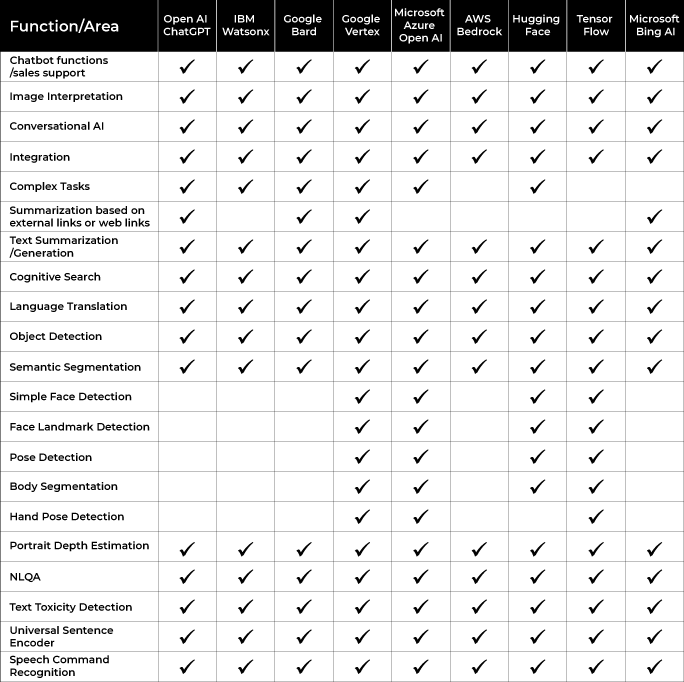Comparative Study of Generative AI Tools
by Ruby Sachan, on Jul 3, 2023 5:42:36 PM
Key takeaways from this blog:
- Generative AI allows machines to generate content or make decisions autonomously, expanding the capabilities of AI beyond predefined rules and patterns.
- Generative AI has various applications, including computer vision, natural language processing (NLP), anomaly detection, machine learning (ML), knowledge mining, and conversational AI.
- The integration of Generative AI with IBM CP4BA offers benefits such as accelerated process execution, enhanced decision making, rapid data or document analysis, intelligent customer service, seamless document extraction, increased efficiency and productivity, and cost-effectiveness.
Evolution of Generative AI:
What is AI? The term "Artificial Intelligence" was coined by John McCarthy in the year 1950. According to him, AI is science of building machine intelligence that is capable of thinking like humans.
Over time, AI has experienced significant advancements, from technologies like SIRI to self-driving cars. Contrary to popular portrayals in movies, AI encompasses a wide spectrum, ranging from Google's search algorithms and IBM's Watson to applications in automated weaponry. The field of AI continues to evolve rapidly, revolutionizing various industries and pushing the boundaries of technological innovation.
What is Generative AI? Generative AI encompasses a classification of artificial intelligence (AI) algorithms that have the ability to generate novel outputs by leveraging the data they have been trained on.
What is Deep Learning? Deep Learning is a subdivision of Machine Learning that places its emphasis on algorithms that draw inspiration from the complex structure and capabilities of the human brain.Types of Deep Neural Network:
- Convolutional Neural Network – mostly used for image analysis.
- Recurrent Neural Network – Uses sequential information to build model, works better to memorize the past data.
- Generative Adversarial Network – are algorithmic architectures which use two neural networks to create new synthetic instances of data that parse real data.
- Deep Belief Network – DBN is a generative graphical model consisting of multiple layers of latent variables known as hidden units.
- Supervised Learning - In supervised learning, data is already labeled, it means systems can locate the target data. Based on historical data, systems have the capability to anticipate future outcomes.
- Unsupervised Learning - Unsupervised learning algorithms employ unlabeled data to discover patterns from the data on their own. Example: k-means clustering, anomaly detection and hierarchical clustering.
- Reinforcement Learning - Reinforcement Learning involves training an agent to accomplish tasks within an environment that is characterized by uncertainty.
Microsoft, AWS, Google, and IBM are prominent global providers of Generative AI. Alongside these industry leaders, several notable Generative AI providers and tools, including OpenAI ChatGPT, Hugging Face, and TensorFlow, are extensively used for various functions such as...
- Computer Vision
- NLP
- NLU
- Anomaly Detection
- ML
- Knowledge Mining
- Conversational AI
Computer vision is the field of technology and study that enables computers to interpret and understand visual information from images or videos. It involves developing algorithms and systems for tasks such as image recognition, object detection, and scene understanding.
NLP (Natural Language Processing)
NLP, a branch of AI, is assigned with the goal of enabling and facilitating various language-related tasks.
NLU (Natural Language Understanding)
NLU is subset of NLP and focus of NLU is to make machines:
- Interpret the natural language
- Derive meaning
- Identify context
- Draw insights
- Name Entity Recognition
Anomaly Detection:
Anomaly Detection is an AI technique that identifies abnormal behavior by comparing it to an established pattern. Anything that deviates from a baseline pattern is considered an anomaly.
Machine Learning:
Machine Learning involves the use of algorithms and analytics to prepare and train data models for predicting business problems.
Knowledge Mining:
Knowledge Mining is an AI discipline that employs intelligent services to rapidly search and learn from vast amounts of information.
Conversational AI:
Conversational AI refers to technologies such as chatbots or virtual agents that enable users to engage in conversations.
Comparative chart of various Generative AI tools:
Datamatics' IBM practice and Centre of Excellence consistently explores and applies Generative AI features to various components of IBM CP4BA, including content services, workflow automation, document processing, decision services, process mining, and RPA. This integration aims to enhance overall efficiency, expedite processing, and deliver faster time-to-value.The integration of IBM CP4BA and Generative AI brings forth several benefits through Datamatics:
- Accelerated process execution
- Improved decision-making capabilities
- Swift analysis of data or documents
- Intelligent customer service solutions like chatbots, email automation, and anomaly detection
- Seamless document extraction
- Increased efficiency and productivity through human-machine collaboration
- Cost-effectiveness
Datamatics boasts extensive experience in understanding large language models such as OpenAI, Vertex AI, Bedrock, and IBM Watson. Additionally, the company maintains ongoing partnerships with various Generative AI providers, including Microsoft, IBM, Google, and AWS, to harness the capabilities of Generative AI tools such as document classification, document summarization, cognitive search, text-to-audio generation, and prompt engineering.
Next Reading

















